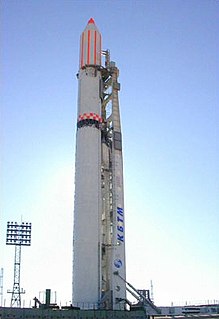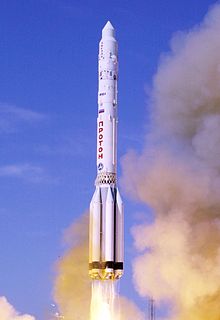
Zenit is a family of space launch vehicles designed by the Yuzhnoye Design Bureau in Dnipro, Ukraine, which was then part of the Soviet Union. Zenit was originally built in the 1980s for two purposes: as a liquid rocket booster for the Energia rocket and, equipped with a second stage, as a stand-alone middle-weight launcher with a payload greater than the 7 tonnes of the Soyuz but smaller than the 20 tonnes payload of the Proton. The last rocket family developed in the USSR, the Zenit was intended as an eventual replacement for the dated Soyuz and Proton families, and it would employ propellants which were safer and less toxic than the Proton's nitrogen tetroxide/UDMH mix. Zenit was planned to take over crewed spaceship launches from Soyuz, but these plans were abandoned after the dissolution of the Soviet Union in 1991.

Zenit was a series of military photoreconnaissance satellites launched by the Soviet Union between 1961 and 1994. To conceal their nature, all flights were given the public Kosmos designation.

The Soyuz-U launch vehicle was an improved version of the original Soyuz rocket. Soyuz-U was part of the R-7 family of rockets based on the R-7 Semyorka missile. Members of this rocket family were designed by the TsSKB design bureau and constructed at the Progress factory in Samara, Russia. The first Soyuz-U flight took place on 18 May 1973, carrying as its payload Kosmos 559, a Zenit military surveillance satellite. The final flight of a Soyuz-U rocket took place on 22 February 2017, carrying Progress MS-05 to the International Space Station.

1971 saw the last three known deaths of cosmonauts of the Soviet space program and the only deaths in space. Their mission was to man humanity's first space station. The experimental bay door failed to separate so the first crew failed to dock and second crew were killed on re-entry. 1971 also saw the launch of the first and only British satellite on top of a British rocket after that success the program was cancelled.

The Soyuz-FG launch vehicle was an improved version of the Soyuz-U from the R-7 family of rockets, designed and constructed by TsSKB-Progress in Samara, Russia. Guidance, navigation, and control system was developed and manufactured by "Polisvit" Special Design Bureau.

The Zenit-2 is a Ukrainian, previously Soviet, expendable carrier rocket. First flown in 1985, it has been launched 37 times, with 6 failures. It is a member of the Zenit family of rockets and was designed by the Yuzhmash.
Orlets was a series of Russian, and previously Soviet photoreconnaissance satellites derived from and intended to augment the Yantar series of spacecraft. Ten satellites were launched between 1989 and 2006; eight in the Orlets-1 configuration and two in the Orlets-2 configuration.

This comparison of orbital launch systems lists the attributes of all individual rocket configurations designed to reach orbit. A first list contains rockets that are currently operational or in development; a second list includes all retired rockets. For the simple list of all conventional launcher families, see: Comparison of orbital launchers families. For the list of predominantly solid-fueled orbital launch systems, see: Comparison of solid-fueled orbital launch systems.
Yantar is a series of Russian reconnaissance satellites, which supplemented and eventually replaced the Zenit spacecraft. Kosmos 2175, a Yantar-4K2 or Kobalt spacecraft, was the first satellite to be launched by the Russian Federation following the dissolution of the Soviet Union. Yantar-Terilen was the first real-time digital system. Yantar satellites also formed the basis for the later Orlets, Resurs and Persona satellites. 179 have been launched, nine of which were lost in launch failures. All Yantar satellites were launched using the Soyuz-U carrier rocket until Kosmos 2480 in 2012 which was announced as the last launch of that rocket from Plesetsk. Subsequent launches used the modernized Soyuz-2.1a rocket. The last Yantar mission was Kosmos 2505, a Yantar-4K2M or Kobalt-M, launched on 5 June 2015. Reconnaissance missions have been taken over by the Persona class of satellites.

The year 2011 saw a number of significant events in spaceflight, including the retirement of NASA's Space Shuttle after its final flight in July 2011, and the launch of China's first space station module, Tiangong-1, in September. A total of 84 orbital launches were conducted over the course of the year, of which 78 were successful. Russia, China and the United States conducted the majority of the year's orbital launches, with 35, 19 and 18 launches respectively; 2011 marked the first year that China conducted more successful launches than the United States. Seven crewed missions were launched into orbit during 2011, carrying a total of 28 astronauts to the International Space Station. Additionally, the Zenit-3F and Long March 2F/G carrier rockets made their maiden flights in 2011, while the Delta II Heavy made its last.

The Proton-K, also designated Proton 8K82K after its GRAU index, 8K82K, was a Russian, previously Soviet, carrier rocket derived from the earlier Proton. It was built by Khrunichev, and launched from sites 81 and 200 at the Baikonur Cosmodrome in Kazakhstan.

The Zenit-3SLB or Zenit-3M is a Ukrainian expendable carrier rocket derived from the Zenit-2SB. It is a member of the Zenit family of rockets, which were designed by the Yuzhnoye Design Office. Produced at Yuzhmash, the rocket is a modified version of the Zenit-3SL, designed to be launched from a conventional launch pad rather than the Sea Launch Ocean Odyssey platform. Most of components of the rocket are produced in Russia.
The Zenit-3F, Zenit-3SLBF or Zenit-2SB/Fregat is an expendable carrier rocket. It is a member of the Zenit family of rockets, which were designed by Yuzhnoye Design Bureau of Ukraine.

Elektro-L No.1, also known as Geostationary Operational Meteorological Satellite No.2 or GOMS No.2, is a Russian geostationary weather satellite which was launched in 2011. The first Elektro-L spacecraft to fly, it became the first Russian geostationary weather satellite to be launched since Elektro No.1 in 1994.
Kosmos 12 or Zenit-2 No.6 was a Soviet optical film-return reconnaissance satellite launched in 1962. A Zenit-2 spacecraft, Kosmos 12 was the seventh of eighty-one such satellites to be launched.
Kosmos 15 or Zenit-2 No.8 was a Soviet optical film-return reconnaissance satellite which was launched in 1963. A Zenit-2 spacecraft, Kosmos 15 was the ninth of eighty-one such satellites to be launched
Kosmos 18 or Zenit-2 No.11 was a Soviet optical film-return reconnaissance satellite launched in 1963. A Zenit-2 satellite, Kosmos 18 was the eleventh of eighty-one such spacecraft to be launched.
Kosmos 20 or Zenit-2 No.13 was a Soviet optical film-return reconnaissance satellite which was launched in 1963. A Zenit-2 satellite, Kosmos 20 was the thirteenth of eighty-one such spacecraft to be launched.
Kosmos 120 or Zenit-2 No.41 was a Soviet, first generation, low resolution, optical film-return reconnaissance satellite launched in 1966. A Zenit-2 spacecraft, Kosmos 120 was the thirty-ninth of eighty-one such satellites to be launched and had a mass of 4,730 kilograms (10,430 lb).
Kosmos 214 or Zenit-4 No.45 was a Soviet, optical film-return reconnaissance satellite launched in 1968. A Zenit-4 satellite, Kosmos 214 was the fortieth of seventy-six such spacecraft to be launched.











